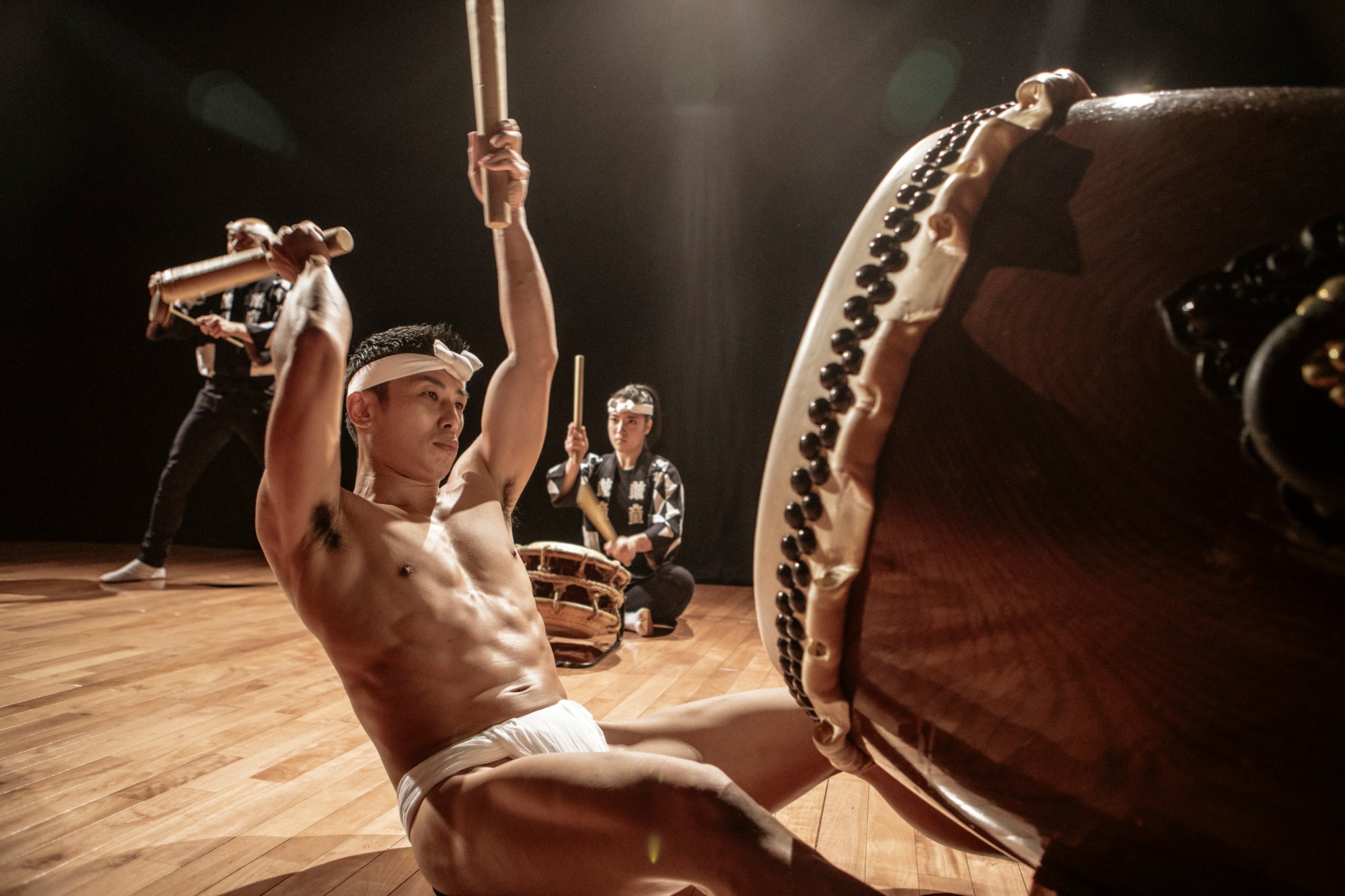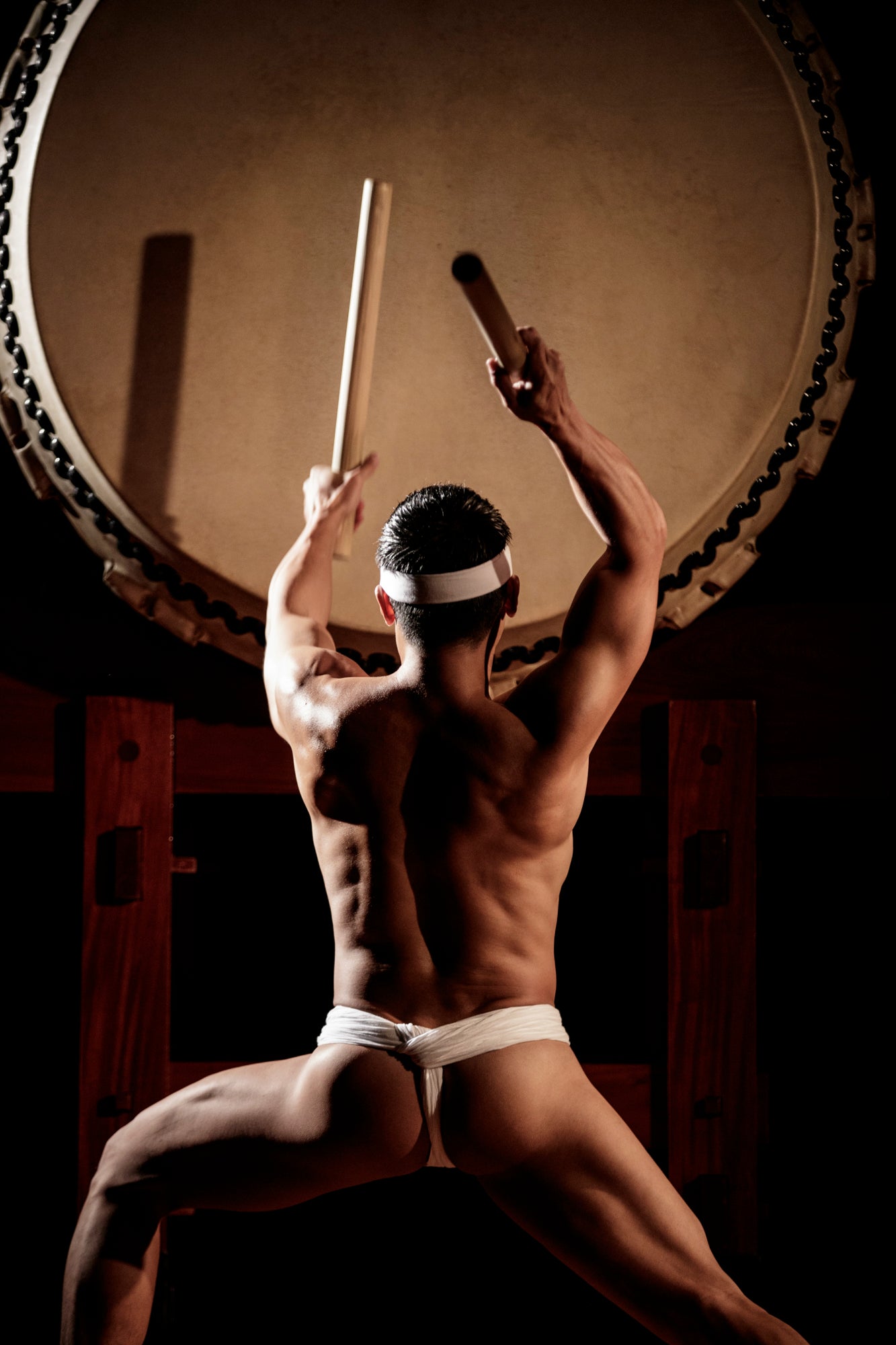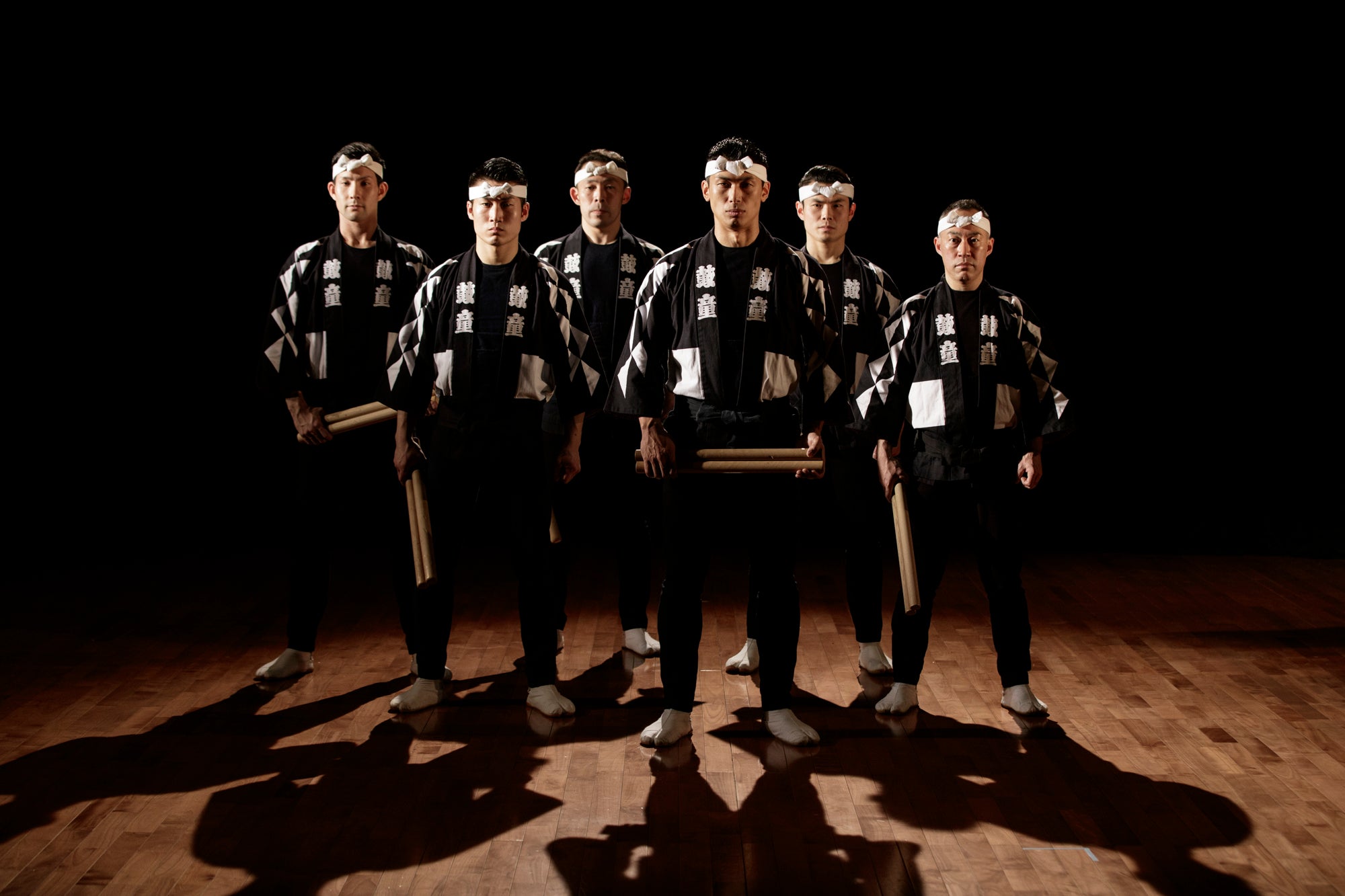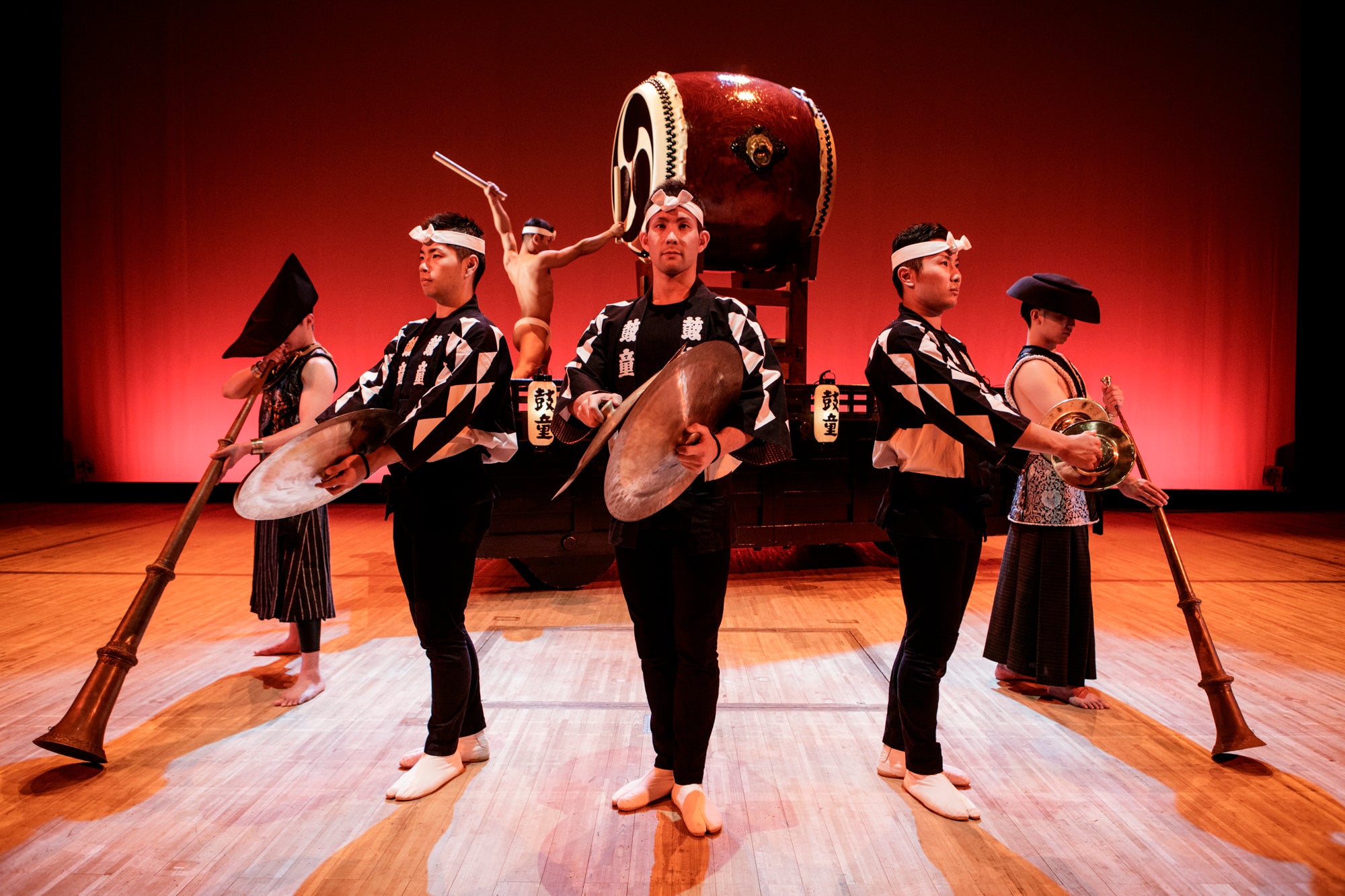No smoking, alcohol, or sex allowed: The difficult task of training as a taiko drummer
The Japanese taiko drumming company Kodo is touring the UK but it’s hard work for the recruits, says Michael Church, as they drum with their whole body, often in punishing positions, after having made their own drumsticks from hardwood block

In medieval times the ruggedly windswept island of Sado, in the Sea of Japan, was a place of exile to which shoguns consigned their political enemies. One of those victims was the 14th-century dramatist Zeami Motokiyo, the father of Noh theatre. “When I go there,” I was told by the Japanese director Yukio Ninagawa while he presented The Tempest as a Noh rehearsal on Sado, “I hear the voices of the dead.”
These days, what you are more likely to hear there is drumming. And I don’t mean rock-music stuff or marching bands: I mean something so intense that it hits you in the gut, rolls over you like an avalanche, and sometimes entrances your ears with its whispering beauty. This is taiko drumming, Kodo style, and for some the coolest thing in the world.
Which is why young people of a somewhat masochistic stamp are queuing up to enrol for a two-year taiko drumming apprenticeship on Sado, and are ready to endure rigours reminiscent of a Siberian penal colony to do so.

Fancy starting your day at 6am with a six-kilometre run up and down a steep mountain path – no rests allowed, no walking, in all weathers including snow? Thereafter your day will be rigidly timetabled, with relentless drilling on drums interspersed with intensive training in a wide range of performance arts, until you tumble into bed from exhaustion at 10pm. There’s no TV in your dormitory, and you’re not allowed to smoke, drink alcohol or have sex. And how are your woodwork skills? You need some because you must fashion your own drumsticks from the hardwood block you’re given at the outset. And will you miss your mobile? There’s just one landline shared with everyone else that you’re allowed to use when you feel a bit lonesome, and want to call home. Inmates at Her Majesty’s prisons have it cushy in comparison.
Kodo is the name of the company that these apprentices – now increasingly female – hope to join after they graduate. But with a mandatory probationary year, followed by a further weeding out, most don’t make the final cut. Although it’s by no means the only professional company focusing on taiko drumming, Kodo is the best-known internationally. Its UK tours always sell out: this year’s will begin at the Basingstoke Anvil on 13 February, and will climax on 15 March at the Liverpool Philharmonic Hall.
There’s a felicitous double meaning in “Kodo”. Its written characters mean “drum child”, but an infinitesimally different stressing of the second syllable will give you the character which means “heartbeat”. The company regards this accidental ambiguity as a symbolic blessing from the gods, and drumming does indeed go way back: it’s one of humanity’s most elemental forms of musical communication.
Taiko drumming dates from the sixth century CE, but this company originated when a visionary musicologist named Den Tagayasu set up a summer school on Sado in 1970, adopting as the house style a muscular tradition unique to Sado called ondeko (demon drumming). Some students stayed on to form a permanent commune, which Den christened Ondekoza: their purpose was to reinvigorate Japan’s regional musical forms and to take them around the world. Members followed a ferociously Spartan regime, limbering up for their assault on the drums by running 20 kilometres every day – in 1975 they astonished the crowd at the Boston Marathon by picking up their drumsticks at the finishing line and launching without pause into a thunderous riff.
But Den grew cranky, and after 10 gruelling years, there was a schism, with most of the group seceding en masse and renaming themselves Kodo. When I visited Kodo in 1993, I was assured that the rigours of the Den era had given way to a mellower lifestyle, but I didn’t see much sign of that – the daily run, with nobody exempt, started at 5.30am, and you could smell the asceticism in the air.
Returning in 2019, I was struck by how little had changed in the intervening time, including the personnel. I had remembered Chieko Kojima as a bewitching dancer, and Yoko Fujimoto as a compelling singer of min’yo folk songs, and here they were again, still charismatic in their sixties and pursuing successful solo careers. “Then Kodo was a family,” says Chieko. “Now it’s a real company, where everyone is respected as an artist, whether they are a drummer, singer, or dancer.”

Here, too, were Motofumi Yamaguchi – in 1993 the company’s democratically elected artistic director – now happily officiating as its lead flautist, and Eiichi Saito, at 56 another of the company’s senior members, who in his spare time leads taiko workshops for elderly people fighting off dementia.
And by 2019 things really had mellowed. Company members no longer have to do the cooking and cleaning; they are now allowed to marry, and to sleep in flats in town, rather than in a dormitory. But the shime-daiko players still have to tighten the tuning ropes on their drums each day – a job which takes two people twenty strenuous minutes – and there is no let-up in the life of the apprentices.
The company’s rehearsal room is full of mirrors in front of which they bend, stretch, arch, and tense as dancers do, and when a performance starts you realise why. Unlike Western drummers, who operate from the wrist, these men and women drum with their whole body, often in punishing positions. Back injuries used to be the commonest reason for quitting the game, but they’re now much reduced, thanks to anatomically intelligent training.

Legacy, the programme which Kodo are bringing to Britain, is a majestic showcase for their art. It’s a kaleidoscopic sequence of pieces in which choral and min’yo interludes, or pieces for bamboo flute plus koto zither, oil the transitions between the set-piece drumming works, each of which is a musical drama deserving to be taken as seriously as any piece by Steve Reich. Beautifully lit, with the male performers in their trademark bandanas and fundoshi loincloths, it’s a feast for the eyes as well as a celebration of virtuosity.
Taiko drums come in many shapes and sizes, from the sharply resonant little shime-daiko, to the barrel-shaped miya-daiko for which the players lie back in an easy rider position and grip the drum between their calves, to the giant odaiko which is hollowed out of a single block of wood, and which can weigh 400kg and be 2m in diameter.
And I am as entranced by the physical drama as by the musical one: the men attacking the miya-daikos with quasi-murderous intent, the women’s left hands flashing faster than the eye can register as they pummel both ends of their double-headed drums, the line of Buddha-like shime-daiko players conjuring up shimmering sonic worlds. These begin with a delicate susurration, the sticks propelled by nothing more than their own weight, then the volume is brought up to a boil which makes the hall shake, before embarking on an antiphonal conversation where each drummer takes his or her turn in the limelight. The arrival of the odaiko – reverently prayed to, before it is played – marks the grand climax of an evening that, though often extremely loud, never once hurts the ears.
Kodo will be at the Anvil, Basingstoke on 13 Feb; the Warwick Arts Centre on 14 Feb; the Lighthouse, Poole, on 16 Feb; the Royal Festival Hall on 13 March; and the Philharmonic Hall in Liverpool on 15 March
Join our commenting forum
Join thought-provoking conversations, follow other Independent readers and see their replies
Comments